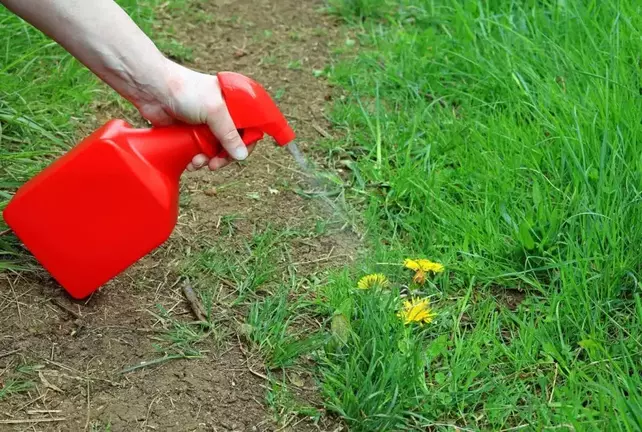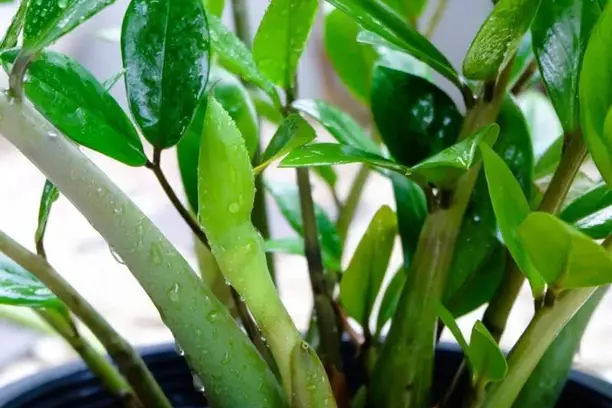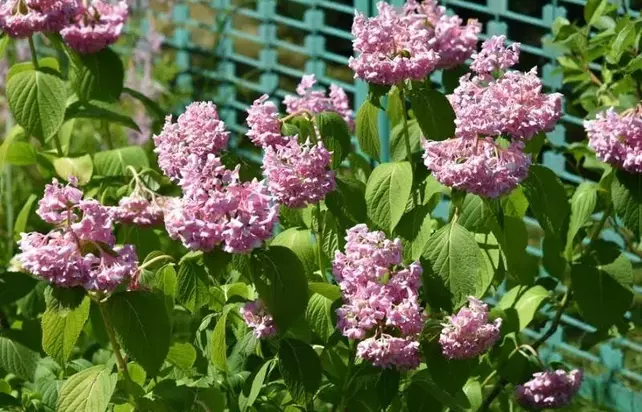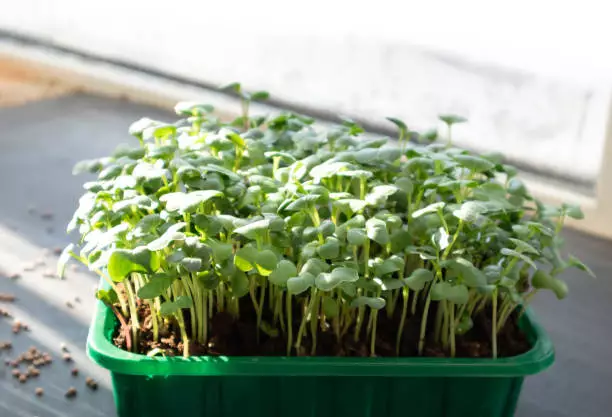Black indoor plants perform best in partial shade or full sun. For most of them, the more sun they receive, the darker their foliage becomes. These plants are technically not black but appear in dark purple, maroon, deep burgundy, or red.
Common black indoor plants include the raven, burgundy rubber plant, Black Magic, Burgundy ripple, Purple Oxalis, and Chinese Jade. You can grow them in well-lit spaces indoors to keep them happy and visible. Dark areas or those with low light will easily conceal the beauty of black houseplants.
If you want to make the most out of plants with black foliage and flowers, I’d recommend you grow them alongside bright-colored plants and indoor trees to give your property a tropical touch.
RELATED: BEST LOW-LIGHT INDOOR PLANTS
Are there plants with black leaves?
Some perennial plants have black leaves but they’re not very common as houseplants. Landscapers get plants with black foliage from directed breeding programs or sport selection and propagation. For example, the ZZ Raven variety was created and patented in the U.S.
RELATED:
The leaves are not “black” per se. The plants produce significant amounts of blue, brown, maroon, or purple pigments that make them appear black. They appear black when they absorb visible light.
On the other hand, plants that absorb red and blue light reflect the green color that’s common in most plants.
Unlike green-leaved plants, which derive their color from chlorophyll, plants with black leaves rely on anthocyanin. Although anthocyanin pigment is not directly involved in photosynthesis, it results in the darkening of flowers, leaves, stems, and even fruits of the black indoor plants.
Anthocyanin is essential for absorbing intense ultraviolet light, otherwise damaging the plant leaves. The black pigments do not interfere with photosynthesis. Biological scientists suggest that plants with black leaves have higher anthocyanin and chlorophyll than green-pigmented leaves.
However, when green-pigmented leaves turn black, it may signal disease and not anthocyanin. You should check for sudden temperature rises and moisture loss in your plants in such cases.
11 Black plants for indoors
Some great indoor plants with black foliage such as the rubber plant, Black Magic, Burgundy ripple, Purple Oxalis, and Chinese Jade are commonly grown in homes. Others like the Persian Shield, Aeonium Arboreum, and Rose Painted Calathea may not be very common.
Here are some of the best black indoor plants for your home:
1. Raven ZZ
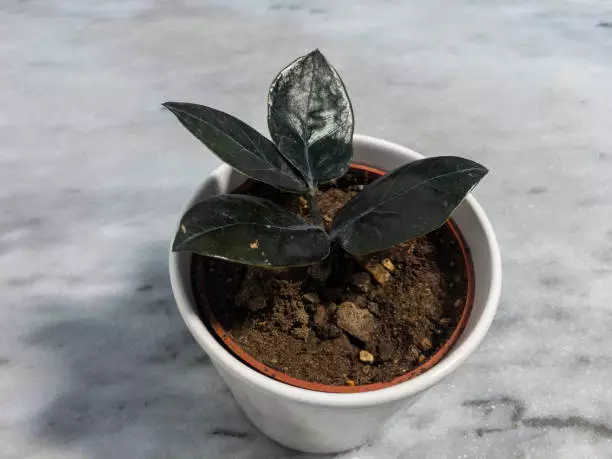
The best black indoor plant is Raven, scientifically known as Zamioculcas zamiifolia (ZZ). With good water and care, the sheen of the Raven ZZ grows with a deep purple-green. It grows slowly and attains its full size relative to the pot’s diameter. For example, in a 45 cm pot, Raven will achieve a maximum height of one meter.
RELATED: HOW TO TAKE CARE OF YOUR ZZ PLANTS
Ensure that the spot you identified to plant Zamioculcas Raven receives bright light. Rooms with east-facing windows are ideal locations for Raven. Such rooms will expose certain areas to indirect but bright natural light from the windows. Raven ZZ will grow best if you leave the soil dry out between weekly waterings.
In an ideal location, Raven’s emerging leaves will appear electric lime-green and slowly transform to a rich shade of purple. It is the best black indoor plant because the effect is mesmerizing. When planted indoors, studies have revealed that Raven ZZ will boost your productivity, reduce your stress levels, and increase oxygen levels in the room.
2. Burgundy rubber plant
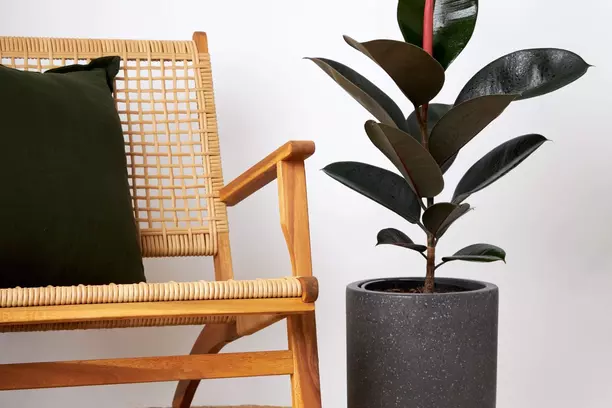
Burgundy rubber plant leaves appear very dark green and have red mid-veins. Young Burgundy leaves are red, but they turn nearly black as they mature. The leaves are about 4” wide and 12” long, and the whole plant will grow about 40” tall if you take good care of it.
If you plant a Burgundy rubber plant indoors, ensure it receives enough light. Otherwise, instead of the black appearance, it will become mostly green. Unlike Raven ZZ, which does not require direct sunlight, the Burgundy rubber plant will thrive in it. Direct sunlight enhances the anthocyanin in Burgundy, giving your space a heavenly look.
Burgundy rubber plants are beautiful and very easy to care for. In summer, you should keep the Burgundy rubber plant moist. For the best black indoor theme, water it once every week. If the leaves are dusty, clean them with a damp cloth or mist them. However, you should water it only once or twice a month during the dormant season.
3. Black magic plant
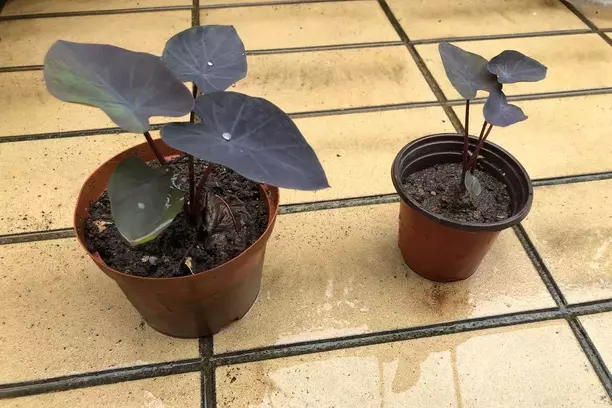
Also known as Colocasia esculenta, the Black Magic (Taro) plant is another best black indoor plant. Its leaves are heart-shaped and have long stalks. As for the color, Black Magic boasts spectacular smoky purplish-black foliage. The plant can grow up to 1 meter long and 2 ft wide under the correct planting conditions.
If you plant Black Magic indoors, keep it in a place that receives full sun or partial shade. However, like the Raven ZZ, Black Magic leaves develop a deep purple color when exposed to bright indirect light. In addition, the potting soil should be rich in organic matter to keep it moist most of the time, not wet.
Unlike Burgundy rubber plants, Taro requires high humidity. So you should water your indoor Black Magic regularly. It is also important to note that it is a perennial plant preferring relatively dry soil in winter. Furthermore, Taro achieves its full growth potential every summer, making your home lively and encouraging productivity.
4. Burgundy ripple
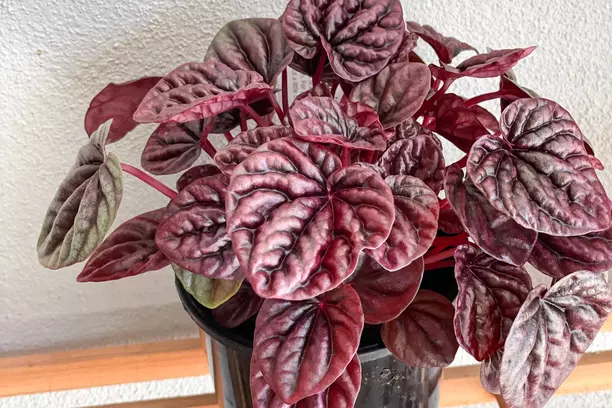
The burgundy ripple is also called Peperomia Emerald Red Ripple. It derives its name from the distinct ripples in the heart-shaped petals. This dark indoor plant has colorful purple-red leaves and stalks and likes to grow in mounds. That makes it great for indoor spaces with partial shade and indirect bright light. Avoid direct sunlight as it can easily make the plant droopy.
I recommend growing Peperomia near a window to allow it to receive enough indirect light. However, if the room relies on artificial light, Burgundy ripple will remain vibrant if it can receive 12 to 16 hours of artificial bright light.
Here are two great benefits of the burgundy ripple:
- It is low maintenance
- It cleans indoor air
When it comes to caring for the Peperomia plant, consider misting the leaves once a day to keep them vibrant. Avoid watering the plant until the top two inches of the soil is dry. Peperomia can grow and make a mound 30cm in length and height with the right care. Indoors, its purplish-red color will integrate beautifully with any white background.
5. Purple oxalis
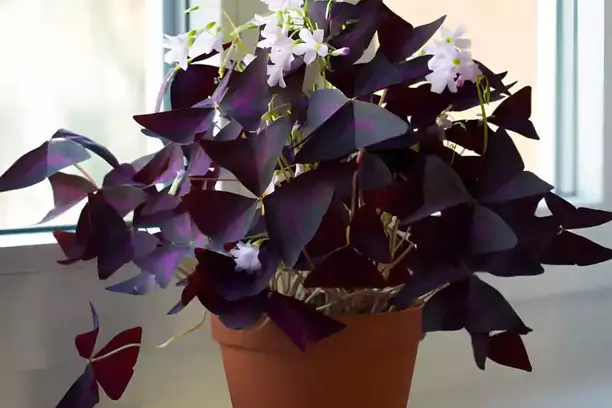
Purple oxalis has unique triangular deep purple leaflets that grow low. The plant blooms during spring. The plant not only makes for amazing black indoor plants but also a good garnish to serve lovely salads.
Their white, pink, and lavender flowers can introduce elegance into your space when they bloom.
Oxalis triangularis can grow to heights between 0.5 and 1 foot and spread up to 2ft wide. Therefore, you can grow them in small and medium pots to introduce a purplish theme indoors.
The best varieties of the purple oxalis to grow indoors are the Oxalis triangularis and O. regnellii because, with proper treatment, they can remain vibrant throughout the year.
Proper care involves pruning once every year, fertilizing every month, and watering in moderation; when one inch of the topsoil has dried out. In other words, water these black indoor plants every two or three weeks.
6. Chinese jade
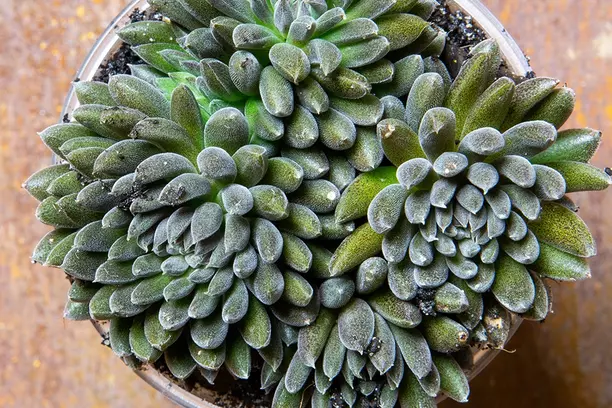
The main identifying feature of Chinese jade is its branched blue-green succulent stems. The shrub symbolizes growth and renewal in some cultures and will fill yours indoors with charm.
Chinese jade plants can grow up to 8 feet tall and 3 feet wide. However, you can keep them short by pruning or growing them in a little pot, depending on your needs.
Plant the Chinese jade close to the entrances in your home where it can receive bright light. Avoid planting the plant in direct sunlight as it loses its dark luster. I’d not recommend keeping the plant in the bedroom or the bathroom.
Despite being an indoor plant with black foliage, the Chinese jade is also a great air-purifying plant for removing volatile organic compounds (VOCs) from your home.
RELATED: INDOOR PLANTS THAT ARE BEST FOR AIR PURIFICATION
7. Aeonium arboreum

The Aeonium Arboreum is a rosette-shaped succulent that requires intense light to yield its full potential for a great dark indoor theme. It turns darker when it receives enough light.
You can grow and care for the Aeonium Arboreum in a pot where it can reach 3 feet high. Place the plant next to windows in your living room or study area that are well lit.
8. Rose painted calathea
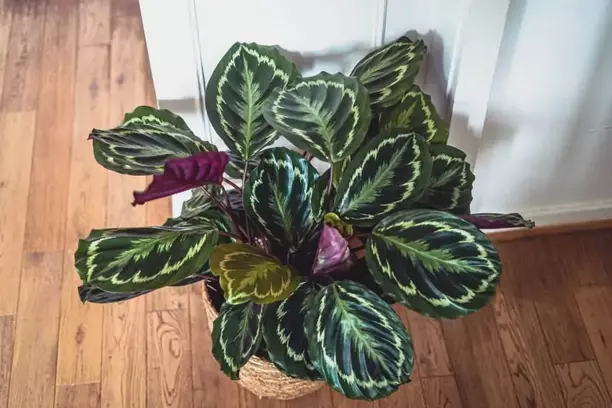
This tropical black indoor plant is native to Brazil. Rose-painted Calathea grows up to 50 cm tall. Its large pinkish leaves are stunning. To keep them darker, raise the humidity by misting the leaves and watering once every one or two weeks.
Not only will it catch the attention of your visitors, but it also contributes significantly to the quality of your indoor climate.
9. Black hens and chicks
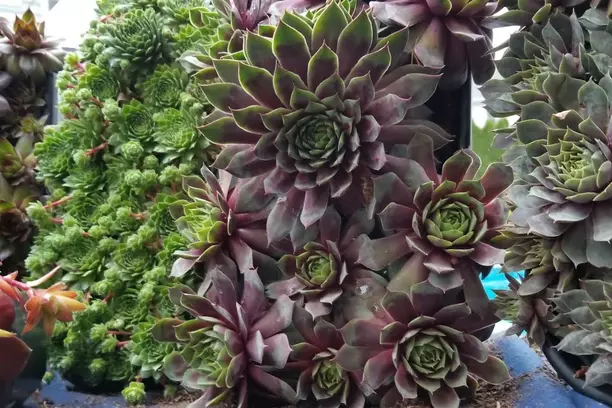
Black hens and chicks are thick, fleshy, and succulent like the Aeonium Arboreum. The plant belongs to the Sempervivum family that has a mat-forming tendency.
Coupled with its purplish-bronze leaves, Sempervivum is so attractive in containers, making it one of the best black indoor plants you can use for indoor decor. It integrates perfectly with light-green or white background themes.
10. Sorbet black delight viola
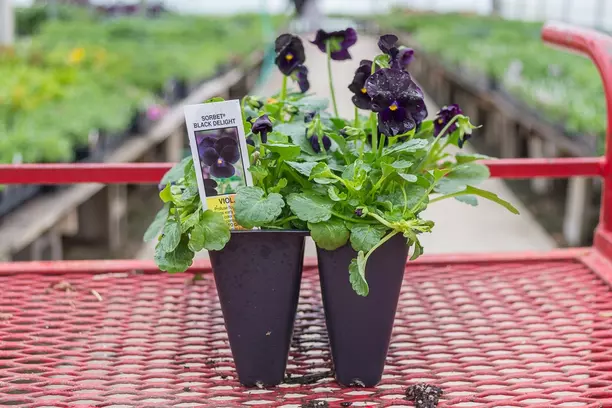
Sorbet Black Delight is popular for its velvety black flowers. The center of the flower is a deep yellow spot that contributes to its elegance.
Sorbet black delight grows up to 15cm tall and spreads between 15 and 20cm wide, making it ideal for indoor areas with small spaces. It will grow well in full sun exposure or partial shade and moist soil.
You can also grow it indoors for use in food salads. As an alternative use, violas are a symbol of decency, innocence, and modesty.
11. Black velvet
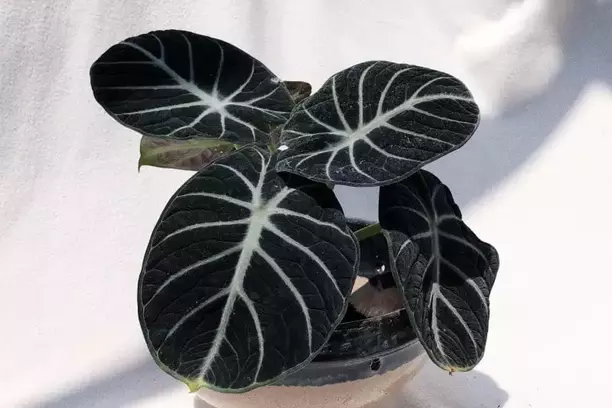
Alocasia Reginula is commonly called the Black Velvet. It is a dwarf plant that grows to about 1 foot tall. Its dark velvety leaves have distinct silvery-white veins that make it outstanding and suitable for indoor planting.
Black velvet will perform well when it receives bright indirect sunlight. You’ll, however, want to make sure it is well-watered and that the soil remains well-draining. Overall, this dark plant is easy to maintain.
